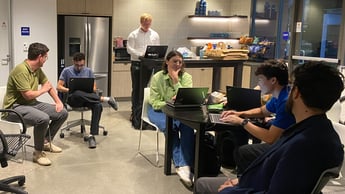Azure IoT tooling explored
Our Itility Cloud Control platform is not only used for managing infrastructure components, but also for managing IoT devices. Recently we organized an Azure IoT portfolio deep dive together with Microsoft, to further explore the latest possibilities of the IoT products offered in the Azure catalog.
Microsoft has chosen a very strong way of productizing their IoT services. They follow a clear “fit for all purposes” strategy by offering many different solutions and rich integrations. From a high-level overview, Azure offers three segmentations in their IoT product portfolio, which can be broken down as followed:
Azure IoT Central (SaaS): the easiest and most simplified IoT application to get up and running quickly. It is a fully managed IoT solution. In a single portal you can manage visualization, connections, devices, rules, and alerts right away. However, while playing around with the Azure IoT central solution we did not yet feel it was at an enterprise grade of readiness. Nevertheless, we were impressed with its capabilities and accessibility, both of which help to speed-up an IoT initiative.
Azure IoT Solution Accelerators (PaaS+): the IoT Solution Accelerators provide a set of templates, which offer a very neat combination of different Azure resources. You can use these to quickly deploy your desired IoT functionality. They allow you to start onboarding your devices and sensors right away, but they are also fully customizable. IoT Solution Accelerators deliver a pre-build vertical that consists of an IoT Hub, Web App, Azure AD integration, Cosmos DB, Time Series, Scale sets, Device simulation, and more. Explaining each of these resources and how to use them would be a blog in itself, but all together they create exactly what you need, and you don’t have to start from scratch. You can also choose a template that fits your business requirements (e.g. Connected Factory, Remote Monitoring or Predictive Maintenance).
Azure IoT Hub (PaaS): the main focus of Azure IoT Hub is your device, the software it runs, and the data it produces. The IoT Hub is available as stand-alone deployment and as part of the Solution Accelerators. It does not come with fancy visualization and dashboarding capabilities, but it will make sure that your device is properly managed and secured. IoT Hub is also a key component when hooking up other Azure cloud services to the IoT data flow, and it fully integrates with edge computing capabilities (Azure IoT Edge).
Azure IoT Edge brings cloud functionality to the edge of your business. For example, we use IoT Edge and IoT Hub to run Azure Streaming Analytics on-site and combine Machine Learning models with algorithms we train in the cloud. Although combining IoT Hub and IoT Edge requires more technical skills than other IoT services from Azure, they are very powerful tools for managing devices, deploying software, and using cloud functionality in places where you were not able to use them before.
But wait, there is more - all of this comes with very powerful SDKs
All three product segmentations are supported by the Azure IoT software development kits (SDKs). A very powerful toolset that Azure offers to developers to integrate devices and applications with their services. The Azure IoT SDKs offer several code libraries in C, Python, Java, .NET, and Node.JS to simplify and accelerate development. For example, you can use various libraries to easily send telemetry data, receive messages and jobs, update configurations, and much more.
During this session we reviewed a lot of interesting Azure tools that enable IoT projects on each scale. But the key take-away is that all these tools are just that – tools. Azure, Google, and AWS each provide different types of tools and it is important to evaluate each case individually. At the end of the day, the focus is on the data and the information you want to get from it. Whether you choose SaaS or PaaS, Ready-To-Go or customization - a good use case is the most important aspect of your IoT project.
So our Itility approach (and my advice) for choosing the right fit is: first find a (small but valuable) use case around your business needs, secondly work backward to select the right toolbox, and then focus on actually implementing it, end-to-end. Including data flow, toolbox, and operationalization, to deliver day to day value.





